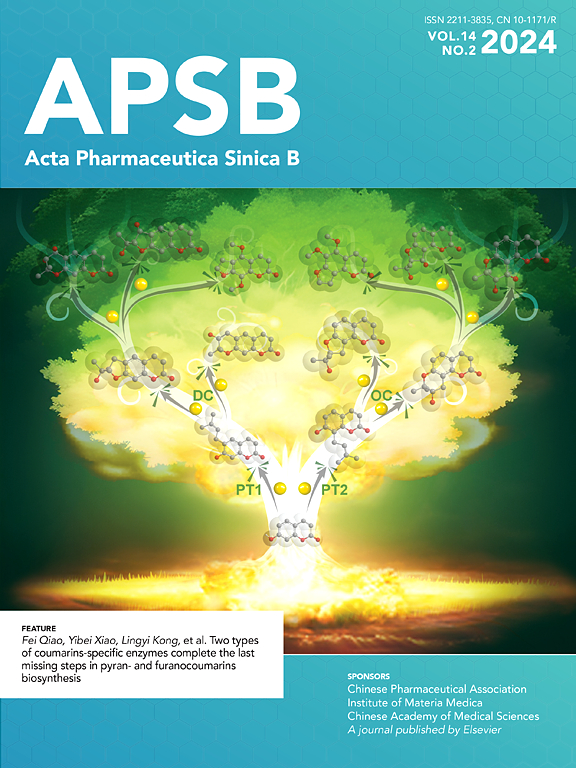雷公司醇负载人参皂苷Rg3脂质体通过重塑黑色素瘤中肥胖相关的免疫抑制肿瘤微环境来促进免疫治疗
IF 14.7
1区 医学
Q1 PHARMACOLOGY & PHARMACY
引用次数: 0
摘要
肥胖通常会加剧免疫抑制性肿瘤微环境(ITME),阻碍CD8+ T细胞的浸润和功能,这进一步成为免疫治疗效果的重要障碍。本研究利用一种包裹celastrol (CEL)的多功能脂质体系统(CR-Lip)重塑肥胖相关ITME,改善癌症免疫治疗,其中人参皂苷Rg3 (Rg3)散布在磷脂双分子层中,其糖基暴露在脂质体表面。CR-Lip具有相对均匀的大小(116.5 nm),通过Rg3与肥胖肿瘤细胞中过表达的葡萄糖转运蛋白1的相互作用,有利于肿瘤组织的积累。CR-Lip到达肿瘤区域后,可诱导HFD肿瘤细胞免疫原性死亡(immunogenic cell death, ICD)。值得注意的是,CR-Lip有效地提高了HFD肿瘤细胞中PHD3的水平,从而有效地阻断了代谢重编程,增加了主要游离脂肪酸燃料来源的可用性。在体内,实验研究发现,易于获得的纳米平台刺激增强了肿瘤组织中各种细胞因子的产生、DC成熟、CD8+ t细胞浸润,并与aPD-1协同抗癌治疗肥胖相关黑色素瘤(肿瘤抑制率为82.1%)。因此,本研究提出了一种有效的肥胖小鼠肿瘤免疫治疗方法,包括肿瘤根除、诱导ICD和代谢重编程。此外,它为肥胖相关肿瘤的免疫治疗提供了一个有价值的尝试。本文章由计算机程序翻译,如有差异,请以英文原文为准。
Celastrol-loaded ginsenoside Rg3 liposomes boost immunotherapy by remodeling obesity-related immunosuppressive tumor microenvironment in melanoma
Obesity usually exacerbates the immunosuppressive tumor microenvironment (ITME), hindering CD8+ T cell infiltration and function, which further represents a significant barrier to the efficacy of immunotherapy. Herein, a multifunctional liposomal system (CR-Lip) for encapsulating celastrol (CEL) was utilized to remodel obesity-related ITME and improve cancer immunotherapy, wherein Ginsenoside Rg3 (Rg3) was detected interspersed in the phospholipid bilayer and its glycosyl exposed on the surface of the liposome. CR-Lip had a relatively uniform size (116.5 nm), facilitating favorable tumor tissue accumulation through the interaction between Rg3 and glucose transporter 1 overexpressed in obese tumor cells. Upon reaching the tumor region, CR-Lip was found to induce the immunogenic cell death (ICD) of HFD tumor cells. Notably, the level of PHD3 in HFD tumor cells was effectively boosted by CR-Lip to effectively block metabolic reprogramming and increase the availability of major free fatty acids fuel sources. In vivo, experiments studies revealed that the easy-obtained nano platform stimulated enhanced the production of various cytokines in tumor tissues, DC maturation, CD8+ T-cell infiltration, and synergistic anticancer therapeutic potency with aPD-1 (tumor inhibition rate = 82.1%) towards obesity-related melanoma. Consequently, this study presented an efficacious approach to tumor immunotherapy in obese mice by encompassing tumor eradication, inducing ICD, and reprogramming metabolism. Furthermore, it offered a unique insight into a valuable attempt at the immunotherapy of obesity-associated related tumors.
求助全文
通过发布文献求助,成功后即可免费获取论文全文。
去求助
来源期刊

Acta Pharmaceutica Sinica. B
Pharmacology, Toxicology and Pharmaceutics-General Pharmacology, Toxicology and Pharmaceutics
CiteScore
22.40
自引率
5.50%
发文量
1051
审稿时长
19 weeks
期刊介绍:
The Journal of the Institute of Materia Medica, Chinese Academy of Medical Sciences, and the Chinese Pharmaceutical Association oversees the peer review process for Acta Pharmaceutica Sinica. B (APSB).
Published monthly in English, APSB is dedicated to disseminating significant original research articles, rapid communications, and high-quality reviews that highlight recent advances across various pharmaceutical sciences domains. These encompass pharmacology, pharmaceutics, medicinal chemistry, natural products, pharmacognosy, pharmaceutical analysis, and pharmacokinetics.
A part of the Acta Pharmaceutica Sinica series, established in 1953 and indexed in prominent databases like Chemical Abstracts, Index Medicus, SciFinder Scholar, Biological Abstracts, International Pharmaceutical Abstracts, Cambridge Scientific Abstracts, and Current Bibliography on Science and Technology, APSB is sponsored by the Institute of Materia Medica, Chinese Academy of Medical Sciences, and the Chinese Pharmaceutical Association. Its production and hosting are facilitated by Elsevier B.V. This collaborative effort ensures APSB's commitment to delivering valuable contributions to the pharmaceutical sciences community.
 求助内容:
求助内容: 应助结果提醒方式:
应助结果提醒方式:


